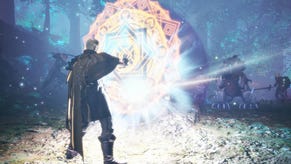Stranger in Paradise: Final Fantasy Origin - technically dated with sub-par performance
And an unforgivably cut-back Series S version.
Stranger of Paradise: Final Fantasy Origin is Team Ninja's latest, a fast-paced action game that serves as a prequel to the original Final Fantasy. Early reports suggested shouldn't expect a technical stunner, but as a new full-price Final Fantasy adventure seemingly built on the Nioh engine, the potential was there for something interesting and worthwhile.
The problem is that the tech is clearly dated, to the point where core rendering elements are reminiscent of the PlayStation 3/Xbox 360 era. Even so, the demands placed on our consoles are significant – to the point finding any machine capable of providing a locked 60fps proves to be a remarkably difficult experience. It's not possible on any of the current-gen machines with only PS4 Pro code running on PS5 getting close. However, remarkably, Xbox One X gets closest to a locked 60fps from all available options, albeit with the uglified rendition of the game's visuals common to all last-gen machines and – unforgivably – on Xbox Series S too.
But let's go back to the technology and what we mean by 'dated' elements in the renderer. Most modern titles use a mix of techniques to approximate the way light behaves as it interacts with different materials. Light bounce, for instance, is typically simulated with global illumination systems, and surface qualities are simulated by using additional values - like albedo, reflectivity, and roughness - in lighting calculations, also known as physically-based rendering. Stranger of Paradise doesn't seem feature these systems - or if they are there, they aren't especially well implemented. Visual design also harkens back to the seventh gen era – aggressive specular and harsh colour grading is the name of the game, almost reminiscent of an Unreal Engine 3 release. In combination with poor post-processing effects and some drastically variable brightness from area to area, the presentation here is not strong.
In fairness, there are some positives. On PlayStation 5 and Xbox Series X, model detail is reasonably high and there's a decent level of geometric density with indoor environments in particular – though texture detail doesn't quite hold up and outdoor areas are blighted by by the bizarre lighting choices. Finally, most of the incidental objects - barrels, tables, pots, and other items - are destructible, and satisfyingly disintegrate as you hit them. Larger objects like pillars are occasionally destructible too, and there are some good-looking precalculated destruction animations in engine-driven cutscenes.
Stranger of Paradise is a dated and inconsistent looking title, but not fundamentally a bad-looking one, but image quality is challenging. Each console has two modes, favouring resolution or performance. However, both target similar resolutions – it's just that the dynamic resolution range in performance mode is wider. PS5 and Series X aim for 4K output in both modes, with Series S targeting 1080p instead. However, actual image quality is questionable as the game uses a collection of image quality techniques that aren't especially effective.
For starters, there's no temporal anti-aliasing, so the image is very unstable and messy. The assets and artwork are relatively detailed and have strong specular elements, so there's a ton of shimmer in gameplay. There does seem to be some form of AA in effect (possibly post-process in nature), although coverage isn't great. Shimmer is common and transparent elements like hair get no anti-aliasing coverage. Secondly, a checkerboarding technique seems to be in effect on the premium machines with tell-tale artefacting, highlighting poor texture detail. Making matters worse is a poor upscaling solution when DRS is in effect – though this may be related to the checkerboarding as while lower in resolution, Series S does not present these issues.
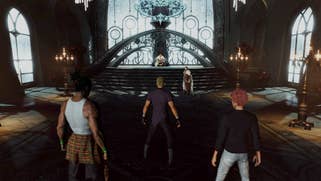

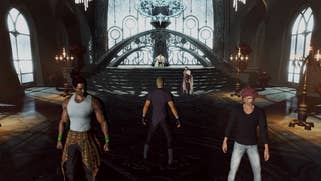
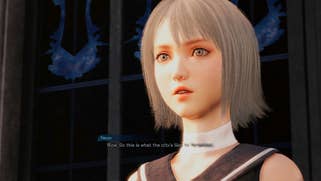

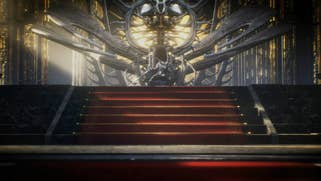
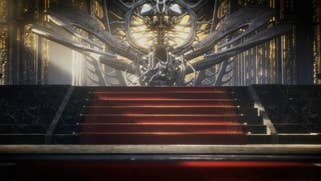
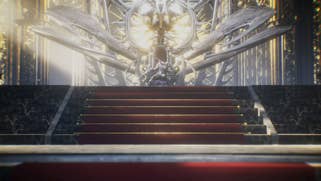




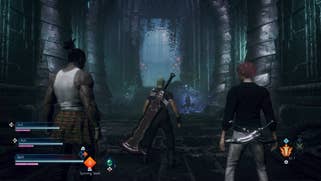
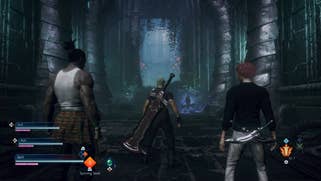
That's just the beginning of the issues though as we move onto platform comparisons. Essentially, Stranger in Paradise seems to have two different visual feature sets – one targeting PlayStation 5 and Xbox Series X and the other targeting last-gen platforms and (unfortunately) Series S. Stranger of Paradise's model and texture details have been sharply reduced on Series S and legacy consoles, with radically simplified environmental detail in terms of both texture quality and polygon counts. It's hard to overstate how different the game looks on Series S. It often looks like a PS3 or 360 rendition of a last-gen game and some of the textures wouldn't look out of place in a PS2 title. Most of the detail and the artistic intent behind it is gone.
Perhaps the strangest difference between the platforms is the general absence of ambient occlusion on Xbox Series X and S. PS5 has a strong and pretty good ambient occlusion effect, whereas on Xbox Series machines the ambient occlusion is much more limited in some scenes and seems entirely absent much of the time. As it stands, Stranger of Paradise looks strangely flat and simple on Microsoft's current-gen machines.
Performance is also problematic in that achieving a locked 60 frames per second is not possible, even on the most powerful machines. On PS5, both visual modes target 60fps but neither does an especially good job of achieving it: the performance mode frequently dips into the low 50s during typical gameplay, with most combat encounters incurring performance drops of some form or another, with finishing moves the worst culprits. To make matters worse, there are sporadic hitches of over 100ms during traversal, possibly related to asset streaming. Resolution mode typically operates with a circa-10fps deficit relative to performance mode. 50-60fps is common in traversal, with 40-50fps the typical readout in combat, and large hitches are still somewhat common. It doesn't feel qualitatively different from performance mode but it does feel noticeably less stable.
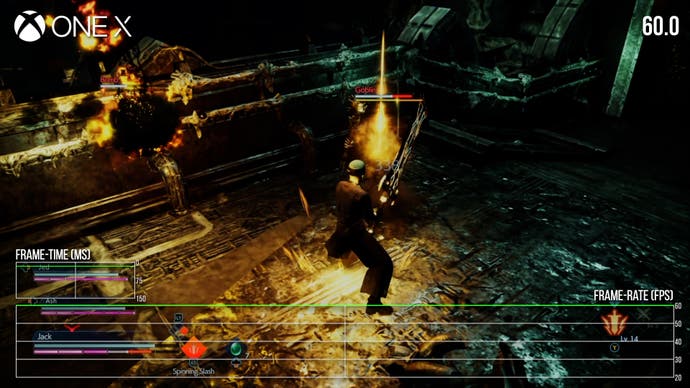
As an aside, real-time cutscenes run at 30fps on all platforms and modes, with similar visual settings between the graphics modes. A few of the initial cutscenes do seem to be pre-rendered but most of the rest appear to run in real-time. 30fps is mostly locked here although these sequences are beset by frame-pacing issues, so they look a bit choppy and inconsistent at times.
Xbox Series X and S are curiously a bit differently configured. The performance mode still targets 60fps, but the resolution mode now operates at 30fps. Performance mode operates very similarly to PS5, with combat typically pushing frame-rates into the 50s, although I couldn't replicate some of the larger framerate stutters on the Microsoft consoles. I can imagine some less discerning players may find them enjoyable but the constant framerate drops really hurt the experience for me. The resolution modes on Series consoles do seem to operate at 30fps without many performance-related dips, but inconsistent frame-pacing returns. This can present as a run of poorly-paced frames or a one-off 50ms frame followed by a 16.7ms one. In gameplay it's quite annoying. There are often stretches of 10-20 seconds between bouts of frame-pacing issues so it's not a constant irritation, but it does really hurt the responsiveness and visual consistency of the resolution modes on Microsoft’s machines.
Is there any way to get stable performance? Yes, but only at a severe trade-off. By running the PS4 Pro code on PS5 under backwards compatibility and selecting the performance mode, you can get a nearly-locked 60fps during gameplay. Unfortunately, this comes at a massive visual hit: resolution is dropped all the way down to 720p, making the game look quite blurry and muddy. Worse still, asset quality is cut all the way down to the Series S standard. It's a hard choice to make - the cuts here are huge - but it does at least perform at a good level. However, there is a 'hidden' mode on PS5. By setting the console to 1080p output and restarting the game, you get access to a native 1080p mode. This mode appears to run the game at a straight 1080p output with no signs of checkerboarding. Frame-rates are a bit better than the performance modes, but performance hangs in the mid to high 50s during most combat. The dips are still quite noticeable unfortunately.
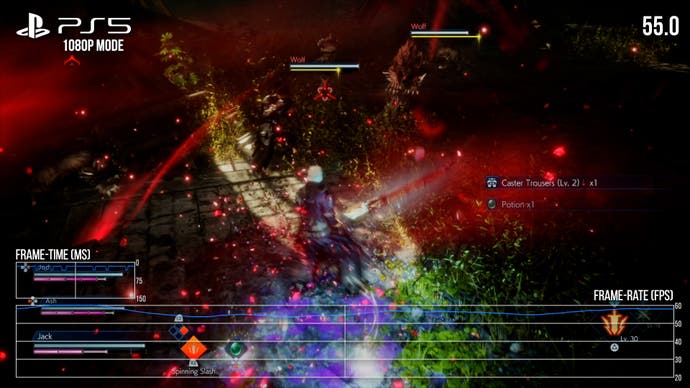
I also looked at the last-gen consoles, where PS4 and Pro retain resolution and performance modes, whereas Xbox machines... don't. Resolution takes a dive, operating anywhere between 720p and 1080p depending on the console and mode, and asset quality is like Series S on all last-gen machines. Interestingly, PS4 Pro and Xbox One X perform fairly well. The Pro holds close to 60fps in typical gameplay in performance mode with occasional dips, with a resolution mode that offers 30fps gameplay with significant dips in combat. One X offers a very consistent, solid 60fps update that feels quite good to play - by far the strongest performer of the native console versions. It looks quite similar to the Series S release but drops frames much more rarely. It may seem odd that One X can outperform Series X and PS5, though the reduced resolution and asset quality surely help here.
PS4 and One S don't fare nearly as well - performance mode on the former fluctuates between 30-60fps, with frequent and hard dips during combat and traversal. Resolution mode targets 30fps but frequently misses it, bottoming out at around 20fps. Xbox One S operates similarly to PS4 in performance mode, but with a wider performance range that stretches between 20 and 60fps. This is not great - the base consoles are playable but only barely. Performance is very poor here but I feared even worse results, coming from the current-gen releases. At least the enhanced machines are reasonably functional, although asset fidelity and image quality remain somewhat dire.
Ultimately, Stranger of Paradise: Final Fantasy Origin is a technically confounding game. Visually it's a throwback that combines reasonably detailed artwork with dated-looking rendering techniques. Some areas look a bit garish or generic but others actually look decent. Expectations should be set appropriately but there's definitely something to appreciate, particularly in some of the more evocative interior areas. It's just a shame that there are so many technical blunders and problems that mar the experience - and quite why Series S gets the last-gen visual feature set is unclear, but it's unwelcome and unacceptable. These problems are unfortunate because the game itself has an interesting enough concept - it plays sort of like a mix between Dark Souls and a character action game like Devil May Cry, with a sprinkling of squad tactics thrown into the mix. Team Ninja knows its stuff here and I enjoyed what I played, at least when I could overlook the game's graphics and performance issues.







